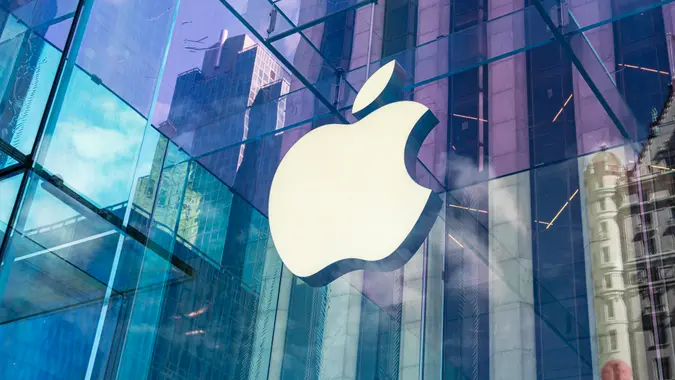Warren Buffett Invested In These 2 Growth Stocks Despite His Long History as a Value Investor

Commitment to Our Readers
GOBankingRates' editorial team is committed to bringing you unbiased reviews and information. We use data-driven methodologies to evaluate financial products and services - our reviews and ratings are not influenced by advertisers. You can read more about our editorial guidelines and our products and services review methodology.

20 Years
Helping You Live Richer

Reviewed
by Experts

Trusted by
Millions of Readers
Warren Buffet is one of the most successful investors of all time, but his reputation of building up his wealth as a value investor sometimes gets misconstrued.
While it’s true that Buffet and Berkshire Hathaway, the holding company that he leads, focus on intrinsic value — meaning the present value of all future cash flows — that doesn’t mean they only invest in value stocks, such as Coca-Cola, Chevron and Bank of America.
Some growth stocks have also proven to be boons for the Oracle of Omaha.
In fact, Berkshire Hathaway’s top stock as a percentage of its equity portfolio is Apple, and the company also holds 10 million shares of Amazon stock, although that’s a much smaller slice of Berkshire’s portfolio.
GOBankingRates broke down why Buffett invested in these growth stocks despite being a value investor for decades.
Why Berkshire Hathaway Invested In These Stocks
Even though these are normally categorized as growth stocks, however, they arguably still align with Berkshire’s, Buffet’s and his late business partner Charlie Munger’s philosophies, said Charles Rinehart, chief investment officer at Johnson Investment Counsel.
“Those investments don’t seem too out in left field,” he said. “Some sources of value maybe just escape a normal price-to-earnings [P/E] ratio.”
Rather than getting too caught up in value in terms of metrics like P/E ratios, these legendary investors have talked about how businesses can create value for shareholders by having durable, competitive advantages, along with moat and pricing power, said Rinehart.
So, while Apple and Amazon are generally considered growth stocks, in the sense that their current stock values generally reflect expectations for substantial future growth, these companies arguably have lots of qualities that some more traditional value stocks have, such as being staples in so many people’s daily lives.
“They’re not the fringe driver of growth in the economy anymore,” said Rinehart. “And they both extend in ways that enable a lot of other businesses to function.”
For example, Amazon’s AWS provides the cloud computing backbone for so many corporations, and Apple has a huge ecosystem of third-party apps running on its App Store, he added.
“So I don’t think that either of those companies are examples that would say Berkshire’s abandoned its focus on value. I think it’s just a difference in the way that you look at growth and look at quality and look at how that emerges in prices over a long period of time,” said Rinehart.
Lessons for Individual Investors
This more flexible way of looking at growth and value stocks, rather than strictly sticking to one category, could be beneficial to some individual investors.
For example, rather than choosing an all-or-nothing approach to investing in funds that are labeled as growth or value, you might instead take a more diversified approach, or you might focus on stocks that share characteristics like being industries with high barriers to entry, regardless of whether they’re technically growth or value stocks.
“I don’t know why individual investors would need to constrain themselves to some of the traditional jargon or categorization schemes that have lived out there,” said Rinehart.
“Growth stocks can have a lot of value to them. And some things that are cheap on paper are not valuable,” he added.
If you do want to invest in a particular style of stocks, then it’s important to dig into the details rather than taking the label at face value, such as buying a large-cap value mutual fund.
“If you’re going to invest that way with a style, then you should be doing research on the front end to know what’s important to the manager, reading what they’re publishing, to make sure they’re sticking to it and just make sure that the results fit the process and that the process isn’t changing,” said Rinehart.
That said, it can be tough for the average investor to gain enough detail on a fund manager’s views, and you might be better off taking a more diversified approach, rather than committing to one style like growth versus value.
“If you’re not convicted in a way that you want to maintain discipline through time, then you’re better off just being broadly diversified,” said Rinehart. “Because the emotional part and the temperament part of investing is really difficult, and it takes a pretty strong North Star to not just chase your tail all the time and try to go after what worked last year. And you’ve got to have a pretty strong worldview to not fall prey to that.”
More From GOBankingRates
- Nearly 1 in 3 Americans Hit by a Costly Holiday Scam, Norton Survey Shows -- How To Avoid This
- Here's What the Average Social Security Payment Will Be in Winter 2025
- How Middle-Class Earners Are Quietly Becoming Millionaires -- and How You Can, Too
- The Easiest Way to Score $250 for Things You Already Do
 Written by
Written by  Edited by
Edited by 

























